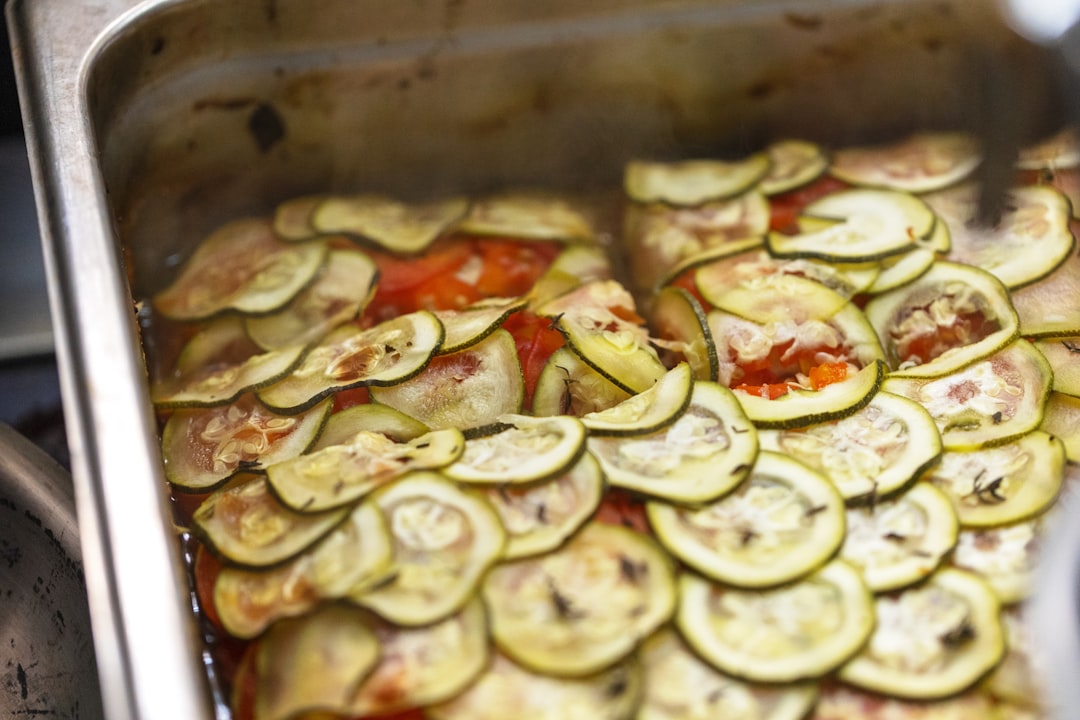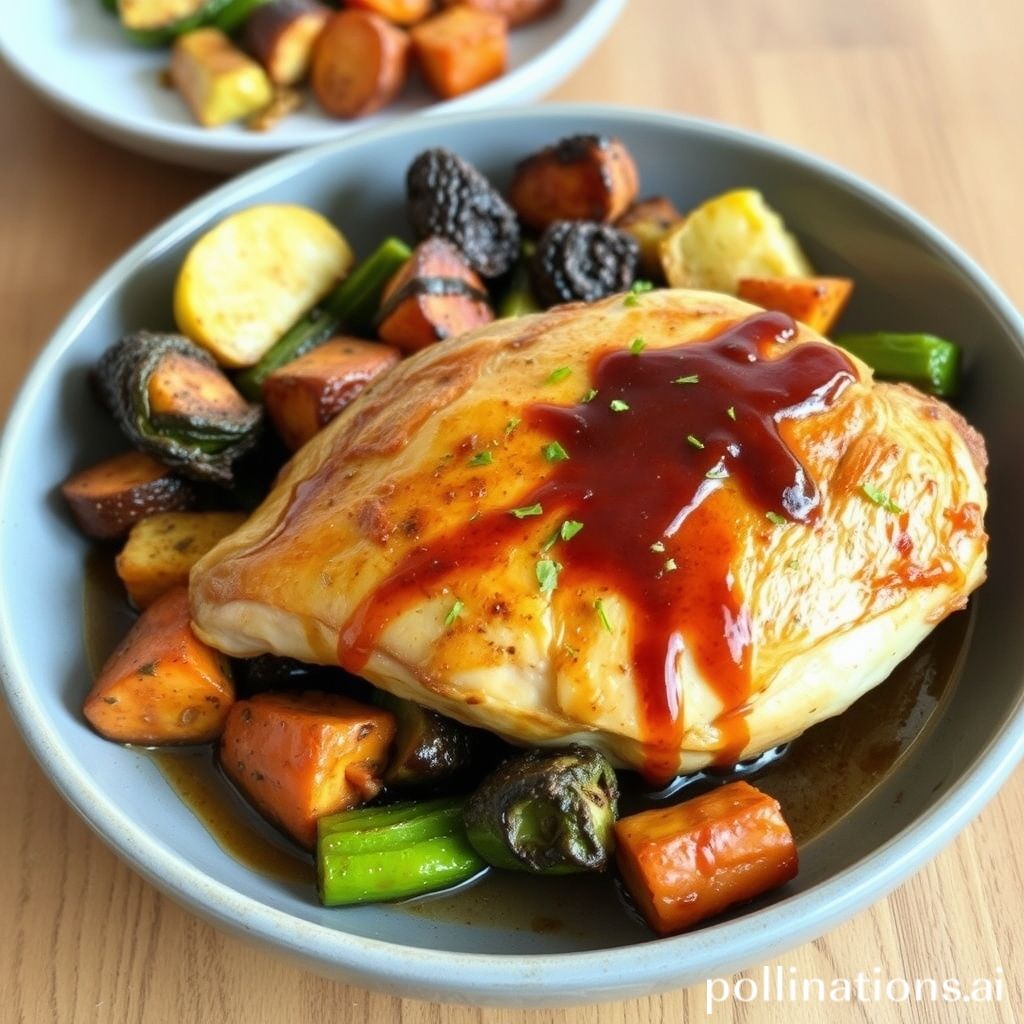Table of Contents
- Introduction
- Ingredients: Exploring Key Elements Such as Chicken Thighs, Balsamic Vinegar, and Vegetables
- Preparation Steps: Marinating the Chicken and Prepping the Vegetables
- Cooking Techniques: Achieving Perfectly Balsamic-Glazed Chicken and Roasted Vegetables
- Flavor Profile: Understanding the Balance of Sweet and Savory Notes in the Dish
- Serving Suggestions: Pairing Balsamic Glazed Chicken with Complementary Side Dishes
- Nutritional Benefits: Health Advantages of Including Chicken and Roasted Vegetables in Your Diet
- Variations and Customizations: Tips for Altering Seasonings and Ingredients
- Common Mistakes to Avoid: Ensuring Successful Balsamic Glazed Chicken with Roasted Vegetables
- Conclusion
- Frequently Asked Questions
Introduction
Imagine unraveling the secret to a luxurious dining experience right in the comfort of your home by crafting an exquisite dish that embodies both elegance and simplicity. Welcome to a culinary escapade with our sumptuous Balsamic Glazed Chicken accompanied by perfectly roasted vegetables. This ensemble not only tantalizes the taste buds but also tickles the senses with its aromatic symphony.
The ingredients for this masterpiece are as follows:
- For the Chicken:
- 4 boneless, skinless chicken breasts
- 1/2 cup balsamic vinegar
- 1/4 cup honey
- 2 tablespoons olive oil
- 3 cloves garlic, minced
- Salt and freshly ground pepper to taste
- For the Roasted Vegetables:
- 1 large red bell pepper, chopped
- 1 yellow bell pepper, chopped
- 2 cups broccoli florets
- 1 red onion, sliced
- 2 tablespoons olive oil
- Salt and freshly ground pepper to taste
Ingredients: Exploring Key Elements Such as Chicken Thighs, Balsamic Vinegar, and Vegetables
When preparing Balsamic Glazed Chicken with Roasted Vegetables, the selection of key ingredients like chicken thighs, balsamic vinegar, and a variety of vegetables forms the foundation of this flavorful dish. Chicken thighs are favored for their rich taste and tender texture, providing a succulent base that contrasts beautifully with the tangy glaze. Balsamic vinegar, known for its deep, slightly sweet acidity, serves as the core of the glaze, imparting a complex depth of flavor that enhances the natural richness of the chicken. This ingredient not only adds a rich dimension but also helps caramelize the exterior for an enticing appearance.
The choice of vegetables, such as carrots, bell peppers, and zucchini, introduces a burst of the season’s best produce. These vibrant vegetables contribute not only color but also an array of nutritional benefits, from the beta-carotene in carrots to the vitamin C in bell peppers. When roasted, they develop a delightful sweetness, perfectly complementing the savory glaze. By combining these carefully selected elements, the dish achieves a harmonious balance of flavors, making it both a nourishing and delightful culinary experience.
Preparation Steps: Marinating the Chicken and Prepping the Vegetables
Marinating the chicken is a crucial step in infusing flavor into your Balsamic Glazed Chicken. Begin by preparing a marinade mixture with balsamic vinegar, olive oil, minced garlic, honey, and a sprinkle of salt and pepper. Place the chicken breasts in a resealable plastic bag or a shallow dish, then pour the marinade over them, ensuring they are evenly coated. Seal the bag or cover the dish and refrigerate for at least 1 hour, or up to overnight for more intense flavor.
While the chicken marinates, you can start prepping the vegetables. Choose a variety of seasonal vegetables like bell peppers, zucchini, and red onions for a colorful array of flavors. Wash and dry the vegetables thoroughly before cutting them into even-sized pieces to ensure they roast uniformly. Toss the vegetables in a bowl with olive oil, salt, pepper, and Italian herbs to enhance their natural taste.
Once both the chicken and vegetables are ready, they can be cooked together, allowing the balsamic glaze to unite the flavors beautifully while baking. This preparation step ensures that every bite of your dish bursts with flavor and succulence.
Cooking Techniques: Achieving Perfectly Balsamic-Glazed Chicken and Roasted Vegetables
Achieving perfectly balsamic-glazed chicken with roasted vegetables involves mastering a few key cooking techniques that enhance flavor and texture. The secret to a flavorful glaze lies in reducing balsamic vinegar until it thickens and becomes syrupy, intensifying its natural sweetness. Begin by simmering the vinegar over medium heat, stirring occasionally until it reduces by half.
When it comes to chicken, using the right cut is crucial. Boneless, skinless chicken breasts or thighs work best as they cook evenly and absorb the glaze thoroughly. Season the chicken with salt, pepper, and your favorite herbs before adding it to a hot, oiled skillet. Sear the chicken on both sides until golden brown, ensuring a flavorful crust forms.
For roasted vegetables, chop your preferred selection—such as bell peppers, carrots, and zucchini—into uniform pieces for even cooking. Toss them in olive oil, salt, and pepper, and spread them out on a baking sheet to roast alongside the chicken at 400°F (200°C). The high heat caramelizes the vegetables, drawing out their natural flavors. Finally, brush the balsamic glaze over the chicken and vegetables, and return them to the oven for a few more minutes to achieve that perfect glaze finish.
Flavor Profile: Understanding the Balance of Sweet and Savory Notes in the Dish
The flavor profile of Balsamic Glazed Chicken with Roasted Vegetables showcases an exquisite balance between sweet and savory notes, making it a delightful experience for the palate. This culinary harmony is mainly achieved through the interplay of balsamic vinegar and the natural sweetness of roasted vegetables.
Balsamic vinegar, with its subtle sweetness and rich, tangy undertone, serves as the foundation of the glaze. When applied to the chicken, it carves out a deliciously caramelized crust during cooking, enhancing the dish’s overall appeal. Its inherent complexity cuts through the richness of the chicken, offering a nuanced contrast that defines the savory element of this dish.
Complementing this is the medley of roasted vegetables, which typically includes hearty root vegetables like carrots and potatoes. Roasting them brings out their natural sugars, adding a gentle sweetness that counterbalances the robust flavors of the balsamic-glazed chicken. The caramelization process also contributes a slight smokiness, rounding out the overall flavor profile with an added layer of depth.
Together, these components create a dynamic dish that relies on the intricate balance of sweet and savory notes, offering a sophisticated taste journey that is both comforting and exciting.
Serving Suggestions: Pairing Balsamic Glazed Chicken with Complementary Side Dishes
When savoring the rich and tangy flavors of balsamic glazed chicken, choosing the right side dishes can elevate your dining experience. This vibrant dish pairs beautifully with a variety of complementary sides, enhancing both its taste and visual appeal. To start, consider a fresh, crisp green salad. Tossing mixed greens with cherry tomatoes, cucumber slices, and a light lemon vinaigrette balances the savory glaze of the chicken, adding freshness to each bite.
Another excellent choice is creamy mashed potatoes or garlic-infused mashed cauliflower, which provide a comforting contrast to the balsamic’s zesty notes. The smooth texture of these sides complements the tender chicken, making each mouthful satisfying and well-rounded.
If you’re in the mood for grains, a side of wild rice or quinoa pilaf could be perfect. These grains absorb the glaze well and add a nutty flavor that pairs harmoniously with the roasted vegetables accompanying the chicken.
Finally, for a touch of sweetness, consider glazed carrots or roasted sweet potatoes. Their natural sugars, caramelized during roasting, echo the sweetness found in the balsamic glaze, creating a symphony of flavors that will delight your palate.
Nutritional Benefits: Health Advantages of Including Chicken and Roasted Vegetables in Your Diet
Incorporating balsamic glazed chicken with roasted vegetables into your diet offers numerous nutritional benefits. Chicken is a high-quality source of lean protein, which is essential for building and repairing tissues, producing enzymes and hormones, and supporting overall health. It provides important nutrients such as vitamin B6, which aids in brain development and function, and niacin, which helps improve cholesterol levels and supports energy production.
Pairing chicken with a variety of roasted vegetables maximizes nutritional intake. Vegetables like bell peppers, zucchini, broccoli, and carrots are packed with vitamins, minerals, and antioxidants. These nutrients play a vital role in maintaining a healthy immune system, reducing inflammation, and protecting against chronic diseases. Roasting vegetables preserves their nutritional content while enhancing their natural flavors, making them more palatable and enjoyable.
Moreover, the balsamic glaze adds a tangy and sweet dimension to the dish without the need for excess fat or salt, making it a heart-friendly option. The combination of protein-rich chicken and nutrient-dense vegetables can help with weight management, support muscle growth and repair, and contribute to overall health and wellness.
Variations and Customizations: Tips for Altering Seasonings and Ingredients
Exploring variations and customizations for your balsamic glazed chicken with roasted vegetables can transform this dish from a simple meal into a culinary masterpiece. One common way to alter the flavor profile is by experimenting with different seasonings. Consider using smoked paprika for a hint of smokiness or adding some red pepper flakes for a spicy kick. Fresh herbs like rosemary, thyme, or oregano can also enhance the aroma and taste.
If you like the balance of sweet and tangy, try incorporating honey or maple syrup alongside balsamic vinegar. This will add a different dimension of sweetness that pairs beautifully with the roasted vegetables.
For those looking to switch up the choice of vegetables, the options are nearly limitless. Sweet potatoes, Brussels sprouts, or even beets can be added to the mix, each offering their unique flavor and nutritional benefits. If you’re a fan of fruit in savory dishes, add slices of pears or apples during the roasting process for an unexpected yet delightful twist.
Lastly, consider marinating the chicken overnight in the balsamic glaze and any additional spices for a deeper, more infused flavor profile. With these simple tweaks, your dish can be just as unique as your personal taste.
Common Mistakes to Avoid: Ensuring Successful Balsamic Glazed Chicken with Roasted Vegetables
Preparing Balsamic Glazed Chicken with Roasted Vegetables can be delightfully rewarding, but avoiding common mistakes ensures the dish’s success. One key mistake to avoid is not marinating the chicken long enough. Allowing the chicken to sit in the marinade for at least a few hours or overnight enhances its flavor and tenderness. Another error is overcrowding the roasting pan. Too many vegetables or pieces of chicken in one space can lead to uneven cooking, impacting the texture.
Additionally, using too little balsamic glaze can result in a lackluster dish. Be generous with the glaze, applying it thoroughly for a rich taste. Paying attention to the roasting temperature is also crucial; roasting at too low a temperature may not caramelize the vegetables properly, while too high a temperature could dry out the chicken.
Finally, neglecting to preheat the oven is a common oversight. Ensuring the oven reaches the correct temperature before placing the dish inside helps achieve the perfect balance between tender chicken and crispy, flavorful vegetables. By avoiding these common pitfalls, your Balsamic Glazed Chicken with Roasted Vegetables will not only look inviting but taste exceptional.
Conclusion
In conclusion, savoring a gourmet meal at home with Balsamic Glazed Chicken and Roasted Vegetables is not just about delicious flavors; it’s about creating a memorable dining experience. This dish, with its expertly balanced sweet and savory elements, offers both nutritional benefits and culinary satisfaction. It requires minimal effort to prepare, yet yields impressive results worthy of any dinner table. By carefully selecting your ingredients, mastering cooking techniques, and avoiding common pitfalls, you can transform a simple meal into a symphonic culinary delight that you, your family, and your guests will cherish. Now, take your chicken cooking skills to the next level by diving into ‘The Chicken Bible: Say Goodbye to Boring Chicken with 500 Recipes for Easy Dinners, Braises, Wings, Stir-Fries, and So Much More.’ Unlock a plethora of creative recipes and fresh inspiration by purchasing the book here. Happy cooking!

